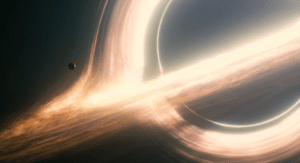Blog
Ambition
26 October 2014
The European Space Agency has released a short film titled Ambition. A mix of science fiction and science, it is visually stunning and captures much of the awe and wonder of space exploration. It’s also part of a growing intersection of science and visual storytelling.
In a few weeks, Christopher Nolan’s Interstellar hits theaters, and will feature rendered black hole images that account for gravitational lensing. The computer-generated black hole was developed with the assistance of Kip Thorne, and is based on the actual physics of general relativity. Similar renderings have been done before, but never at a cinematic scale.
 Interstellar
InterstellarIn recent years “reality” science has made a comeback not seen since Kubrick’s 2001. With sophisticated computer technology and modern production methods, what once was impossible to put to film can now be made real. Movies such as Alfonso Cuarón’s Gravity has a visual feel that even astronauts lauded, though its science was hardly accurate.
To be honest, this rise of science movies leads me to mixed emotions. On the one hand, the storytelling and visuals captures the ambition many scientists have to explore the universe. Movies can capture the emotions behind our research in a way that most scientists can’t. On the other hand, Hollywood science tends to feed misconceptions, and risks spreading the CSI effect. If a manned mission to Mars can be made with the hum of a computer rendering farm, what’s the big deal about landing on a comet. Our real triumphs pale in comparison to cinematic dreams.
Then again, these dreams might actually inspire us to continue exploring. From cinematic dreams we may find the ambition to make them real.